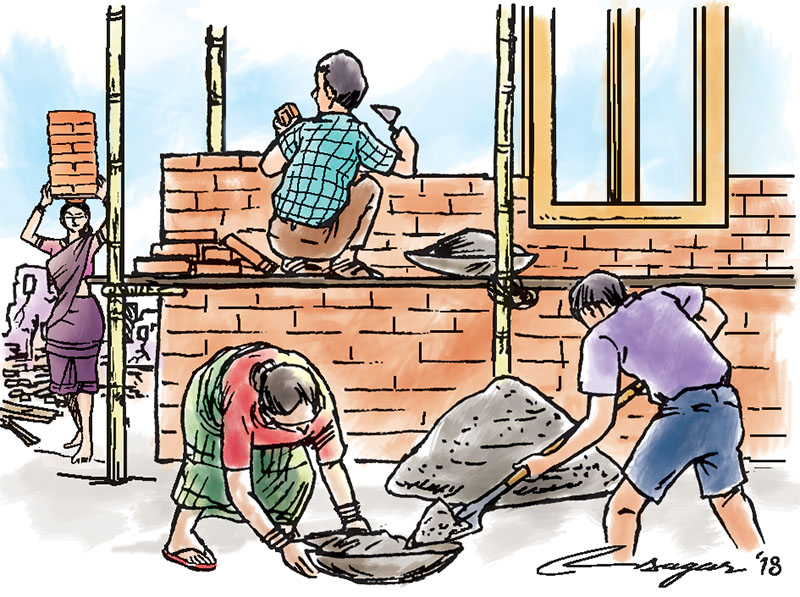Fault lines: Broadening quake hazardscape
The exponential increment in the loss in the case of future natural hazards is inevitable and to overcome this, a holistic plan based on studies and centralised efforts are needed
Nepal observes National Earthquake Day on January 16 every year in commemoration of the great Eastern Nepal earthquake in 1934. But as usual, our focus is on implementation of building codes, reinforcement of bar detailing, awareness and risk reduction strategies. Then how much are we focusing on earthquake as a physical phenomenon? Had it been the earthquake alone, losses could be barely numbered and notified. However, earthquakes seldom lead to losses; the built environment as an integrated entity causes the holistic losses and damage. Cascading and interacting hazards following the earthquakes could have a dominant share on damage and loss statistics. It is high time we reframed the conventional approach of isolating earthquake while dealing with its hazards. In fact, earthquake is a series of events culminating in disfiguring of social strata, human habitats and natural set-ups.
A recent scholarly publication that assesses the social vulnerability to natural hazards in Nepal says 46 districts are under moderate to high social vulnerability level. Most parts of Nepal may observe disastrous scenario in the case of natural hazards. The avalanches and landslides following the 1934 and 2015 earthquakes are examples of cascading effects. Social vulnerability to natural hazard also assesses the resilience among the people residing in the administrative boundary.
After the 1934 earthquake, Nepal refused most of the monetary and other supports stating that the government together with the Nepali people could cope with the devastation. On the contrary, Nepal organised a donors’ summit following the 2015 earthquake and over 400 billion rupees was pledged by the international community for the reconstruction of private houses, as well as heritage structures with which sentimental values are associated.
Nearly 9,000 people were killed and millions of houses and other infrastructure were damaged in the earthquakes that struck the country in April and May 2015.
Undoubtedly, resilience had attenuated and social vulnerability had gone up in Nepal in 2015 compared to 1934. Uncoordinated action, isolation of earthquake and associated interventions may not comply with the integrated resilience that most of today’s scientists and policy makers expect.
Isolating earthquake as a physical phenomenon and focusing merely on social aspects create situation like in Haiti after the 2010 earthquake, where the losses due to cascading hazards surpassed the earthquake loss. Society is the utmost unit that could handle every hazard; be it an independent or cascading. But a resilient society is a must to cope with such hazard.
To this end, earthquake science and preparedness measures require assessment of social vulnerability. Widened earthquake hazardscape now should focus on socio-economic and infrastructural as well as built environment characteristics.
Apart from this, basic needs, gender, disability issues and population in a particular area, among others are vital in restraining the impacts of natural hazards.
Sustainability issues in earthquake risk reduction, gender-based perception issues as noted by Prof Rajesh Rupakhety’s research group for Icelandic earthquakes, climate change and earthquake dynamics as surfaced recently, conjecture that isolating earthquake merely represents the status-quo.
The 2015 Gorkha earthquake, 2011 Nepal-Sikkim earthquake and 1988 Eastern Nepal earthquake could be enough to constrain the ex-ante earthquake loss panorama.
In fact, the discrepancies underpin the complex though understandable nexus and vicious mechanism of hazard interaction and the summed-up losses after the sequence of hazards.
As risk is usually noted as the function of hazard, vulnerability, exposure, resources and preparedness activities, Nepal’s current focus seems very much unidirectional. To be precise, forcing people to go for the 12x12-inch pillars has nothing to do with the losses and damage attributed to the non-structural components; neither has it got anything to do with a physically disadvantaged family member in the house.
Focus of Nepal seems to be somewhere else. We are still relying on hit and trial of imported technologies. Data access, collection, update and distribution mechanisms have been paralysed as noted in the recent publication on social vulnerability.
The exponential increment in the loss in the case of future natural hazards is inevitable. To overcome this, a holistic planning is required. To prepare a holistic plan, thorough studies and centralised efforts are needed rather than isolated and scattered approaches.
The 20th National Earthquake Safety Day is about doing a much more in terms of broadening the hazardscape, especially when it comes to reaching out to the communities. Otherwise, the paradigm created after the Gorkha earthquake, reconstruction even at the riskiest topography, would be an eternal practice. There is a need to invest in researches. Learning from the global lessons of earthquake as a natural hazard and considering the status-quo of Nepal, multi-hazard scale preparedness is the need of the hour.
Gautam is a researcher in structural earthquake engineering






